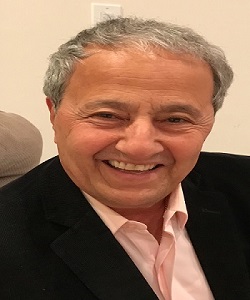
واشنطن- بيني وبين الصباح عقد اتفاق ! بنوده لفصليّ الربيع والصيف تلزمني استقباله في الحديقة : تربتها، أشجارها، أزهارها، و زوارها ، في فصل الربيع بالذات ،من العصافير، مختلفة الفصائل،جميلها. تنتظرني. آتيها بالطعام. تدور حولي مزقزقة مغردة، تعلو وتهبط ،فإنْ أنا فرغتُ من وضعه في الأوعية المخصصة،يأخذ كل منها مكانه، قد يتدافع مع غيره ،لكن دون عنف. لكل رزقه، كما تمليه عليه طبيعته. الكاردينال ،هو الوحيد المتنمر، يتشاجر لامتلاك موقعه، و يدافع عنه بشراسة، يُغْفَر له هذا السلوك لجماله الساحر. راقبته هذا الربيع. قصدت المراقبة لأعرف إلى أين تأخذه هذه ” الأنَفَة”!. يا لسحر ما رأيت: يطير مع أنثاه ، بعيداً عن باقي الطيور، إلى إحدى طاولات حديقة منزلنا الخلفية، . يطمئن عليها ، ثم يطير مرة أخرى . تنتظره. يذهب إلى وعاء الطعام. يطرد بعض ما حوله من طيور. ينقر ما استطاع نقره. يعود إليها به ،وينقله من منقاره إلى منقارها. يكرر الإطعام! لوحة من العشق و لا أجمل .
وأنا منتشٍ بهذا المشهد الشاجن! تلامس المنقارين، ارتعاشة الجناحين فرحاً، تساءلت : تُرى هل القُبَل التي يطبعها أحدنا على خد أو جبين الآخر ،أو تلك التي تأخذ تعريفاً أعمق بين العاشقين ، قد جاءتنا من هذه المخلوقات الجميلة… العصافير!
يقول علماء الانثربولوجيا – علماء الإنسان – بأنه قد تكون لملامسة الفم بالفم جذور في سلوك بعض الحيوانات، كالقرود والطيور، خاصة تلك التي تمضغ الطعام ثم تنقله إلى صغارها عن طريق الفم.و يقترب العلماء أكثر إلى “ربط سلوك بعض أنواع القردة ،مثل البونوبو والشمبانزي في ملامسة الشفاه،كطريقة للتعبير عن الحب والمسامحة، ليعتقدوا أن هذا السلوك الفطري قد “تطور مع الزمن ليصبح إشارة حنان وارتباط للتعبير عن الحب و المودة عند البشر.”
ويشير العلماء إلى أن أول آثار مسجلة للقبلة البشرية تعود إلى نحو 4500 سنة، ومع ذلك فهم، أي العلماء، يعتقدون أن هذا الفعل وُلِد قبل الذاكرة، ربما منذ ملايين السنين، حين اكتشفت الحياة، لأول مرة، دفء القرب، ورقّة اللمس. و تستمر الأبحاث، كما لو أن البشرية تحاول تذكّر اللحظة التي اكتشفت فيها العاطفة لأول مرة، والمتعلق منها بالقُبل بالذات…
يزيد علماء الأنثروبولوجيا الجزيئية – المرتبطة بالجسد – بالقول إن القبلة تحفز مواد كيميائية في الدماغ مثل الدوبامين Dopamine المتحكّم بالمشاعر واللذة، و الأوكسيتوسين Oxytocin هرمون الإرتباط و العاطفة والدفء، وهي ذاتها التي تربط الأم بطفلها والمحبين بعضهم ببعض…
أعود لكاردينالي المتنمّر العاشق، أتمنى لو يعود هو نفسه وأنثاه ،أوآخران مثلهما، إلى حديقتي في الربيع القادم… سأنتظرهما … و أرقبهما على طاولة عشقهما.. سأحاول احتضانه براحتيّ كفيّ، ألامس منقاره الصغير، أهمس في أذنه الصغيرة : شكراً لهذا المنقار الجميل، بسببه صار للقبل مقامٌ جليل عندي.
بوابة الشرق الأوسط الجديدة
Kisses…Did they come to us from the birds?
Washington- Between me and mornings there is a pact! Their covenant binds me, through spring and summer, to welcome them in my garden: its soil, its trees, its flowers, and its visitors — especially in spring — the little birds of many beautiful species. They await me. I come to them with food. They flutter around me, chirping and singing, rising and dipping. When I finish filling their feeders, each takes its place — sometimes jostling a little, but never violently. Each gets its share, as their nature dictates.
Only the cardinal is aggressive — quarreling to defend his spot fiercely. But his beauty excuses his temper. I watched him this spring, on purpose, wanting to see where his “arrogance” would take him. And what a captivating sight it was: he flies with his mate, away from the other birds, to one of the tables in our backyard garden. He checks on her, then flies away again. She waits. He goes to the food bowl, chases away some birds, pecks at the seeds, and returns to her — transferring what he gathered from his beak to hers. He repeats the feeding! A scene of love — pure and breathtaking.
As I was intoxicated by this tender vision — the touching of their beaks, the tremor of wings in joy — I wondered: could it be that the kisses we plant on a cheek or forehead, or those that take on deeper meanings between lovers, came to us from these lovely creatures… the birds?
Anthropologists say that the act of mouth-to-mouth contact may have roots in animal behavior — in birds and primates — especially in species where the mother chews food and passes it to her young through the mouth. Scientists go further, linking the lip-touching behavior of some primates, such as bonobos and chimpanzees, to expressions of love or reconciliation. They believe this instinctive behavior evolved over time into a human gesture of affection and forgiveness.
They also note that the earliest recorded evidence of the human kiss dates back around 4,500 years — and yet they believe the act itself was born long before memory, perhaps millions of years ago, when life first discovered the warmth of closeness and the tenderness of touch. Research continues, as if humanity were trying to remember the moment it first discovered emotion — especially the one we call the kiss.
Molecular anthropologists add that kissing triggers chemicals in the brain, such as dopamine — which governs pleasure and emotion — and oxytocin, the hormone of bonding, affection, and warmth, the same that ties mother to child and lovers to one another.
I return to my proud, passionate cardinal. I hope he and his mate — or another pair like them — will return to my garden next spring. I’ll wait for them. I’ll watch them again on their table of love. I’ll try to cup him gently in my palms, touch his small beak, and whisper in his tiny ear: thanks to this beautiful beak, kisses have gained a noble place in my thoughts.
Great Middle East Gate




